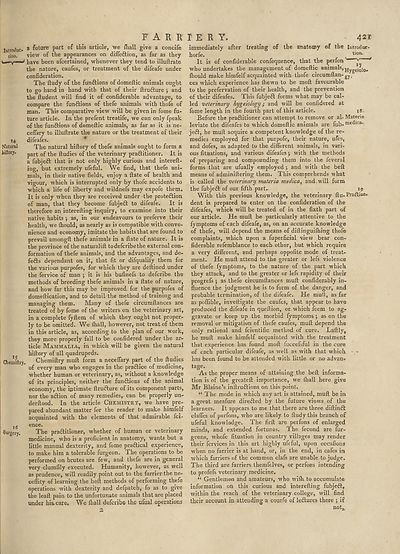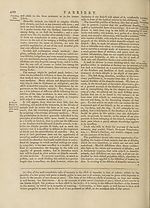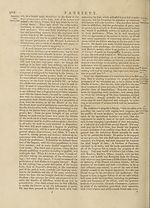Encyclopaedia Britannica, or, a Dictionary of arts, sciences, and miscellaneous literature : enlarged and improved. Illustrated with nearly six hundred engravings > Volume 8, ELE-FOR
(451) Page 421
Download files
Complete book:
Individual page:
Thumbnail gallery: Grid view | List view

FAR 11' r E R Y.
421
Introduc¬
tion.
14
Natural
kiltory.
*5
Cnemiftry.
i5
Surgery.
a futdfe part of this article, we fliall give a concife
view of the appearances on diffeftion, as far as they
have been afcertained, whenever they tend to illuftrate
the nature, caufes, or treatment of the difeafe under
conlideration.
The ftudy of the funftions of domeftic animals ought
to go hand in hand with that of their ftrufture j and
the ftudent will find it of confiderable advantage, to
compare the fun&ions of thefe animals with thofe of
man. This comparative view will be given in fome fu¬
ture article. In the prefent treatife, we can only fpeak
of the fun&ions of domeftic animals, as far as it is ne-
ceffary to illuftrate the nature or the treatment of their
difeafes.
The natural hiftory of thefe animals ought to form a
part of the ftudies of the veterinary practitioner. It is
a fubjeft that is not only highly curious and intereft-
ing, but extremely ufeful. We find, that thefe ani¬
mals, in their native fields, enjoy a ftate of health and
vigour, which is interrupted only by thofe accidents to
which a life of liberty and wildnefs may expofe them.
It is only when they are received under the protection
of man, that they become fubjeft to difeafe. It is
therefore an interefting inquiry, to examine into their
native habits 5 as, in our endeavours to preferve their
health, we fhould, as nearly as is compatible with conve¬
nience and economy, imitate the habits that are found to
prevail amongft thefe animals in a ftate of nature. It is
the province of the naturalift todefcribethe external con¬
formation of thefe animals, and the advantages, and de-
feds dependant on it, that fit or difqualify them for
the various purpofes, for which they are deftined under
the fervice of man ; it is his bufinefs to defcribe the
methods of breeding thefe animals in a ftate of nature,
and how far this may be improved, for the purpofes of
domeftication, and to detail the method of training and
managing them. Many of thefe circumftances are
treated of by fome of the writers on the veterinary art,
in a complete fyftem of which they ought not proper¬
ly to be omitted. We fhall, however, not treat of them
in this article, as, according to the plan of our work,
they more properly fall to be confidered under the ar¬
ticle Mammalia, in which will be given the natural
hiftory of all quadrupeds.
Chemiftry muft form a neceflary part of the ftudies
of every man who engages in the praClice of medicine,
whether human or veterinary, as, without a knowledge
of its principles, neither the functions of the animal
economy, the iotimate ftruCture of its component parts,
nor the aCtion of many remedies, can be properly un-
derftood. In the article Chemistry, we have pre¬
pared abundant matter for the reader to make himfelf
acquainted with the elements of that admirable fci-
ence.
The praCtitioner, whether of human or veterinary
medicine, who is a proficient in anatomy, wants but a
little manual dexterity, and fome practical experience,
to make him a tolerable furgeon. The operations to be
performed on brutes are few, and thefe are in general
very clumfily executed. Humanity, however, as well
as prudence, will readily point out to the farrier the ne-
ceflity of learning the belt methods of performing thele
operations with dexterity and defpatch, fo as to give
the leaft pain to the unfortunate animals that are placed
under his-care. We lhall defcribe the ufual operations
Z
immediately after treating of the anatomy
horfe.
It is of confiderable confequence, that the perfon ^
who undertakes the management of domeftic aniro^Hyge^oIo-
fhould make himfelf acquainted with thofe circumftan-gy.
ces which experience has (hewn to be moft favourable
to the prefervation of their health, and the prevention
of their difeafes. This fubjeCt forms what may be cal¬
led veterinary hygeiology; and will be confidered at
fome length in the fourth part of this article. 18
Before the praCtitioner can attempt to remove or al- Materia
leviate the difeafes to which domeftic animals are fub-mec*lca'
jeCt, he muft acquire a competent knowledge of the re¬
medies employed for that purpofe, their nature, ufes,
and dofes, as adapted to the different animals, in vari¬
ous fituations, and various difeafes \ with the methods
of preparing and compounding them into the feveral
forms that are ufually employed ; and with the beft
means of adminiftering them. This comprehends what
is called the veterinary materia medico, and. will form
the fubjeCt of our fifth part- 19
With this previous knowledge, the veterinary ftu-Practice*,
dent is prepared to enter on the confideration of the
difeafes, which will be treated of in the fixth part of
our article. He muft be particularly attentive to the
fymptoms of each difeafe, as, on an accurate knowledge
of thefe, will depend the means of diftinguilhing thofe
complaints, which upon a fuperficial view bear con¬
fiderable refemblance to each other, but which require
a very different, and perhaps oppofite mode of treat¬
ment. He muft attend to the greater or lefs violence
of thefe fymptoms, to the nature of the part which
they attack, and to the greater or lefs rapidity of their
progrefs j as thefe circumftances muft confiderably in¬
fluence the judgment he is to form of the danger, and
probable termination, of the difeafe. He muft, as far
as pofiible, inveftigate the caufes, that appear to have
produced the difeafe in queftion, or which feem to agr
gravate or keep up the morbid fymptoms j as on the
removal or mitigation of thefe caufes, muft depend the
only rational and fcientific method of cure. Laftly,
he muft make himfelf acquainted with the treatment
that experience has found moft fuccefsful in the cure
of each particular difeafe, as well as with that which
has been found to be attended with little or no advan*
tage.
As the proper means of attaining the beft informa¬
tion is of the greateft importance, we fhall here give
Mr Blaine’s inftrmEtions on this point.
“ The mode in which any art is attained, muft be in
a great meafure directed by the future views of the
learners. It appears to me that there are three diftinft
claffes of perfons, who are likely to ftudy this branch of
ufeful knowlodge. The firft are perfons of enlarged
minds, and extended fortunes. The fecond are fur-
geons, whofe fituation in country villages may render
their feryices in this art highly ufeful, upon occafions
when no farrier is at hand, or, in the end, in cafes in
which farriers of the common clafs are unable to judge.
The third are farriers, themfelves, or perfons intending
to profefs veterinary medicine.
“ Gentlemen and amateurs, who wifh to accumulate
information oh this curious and interefting fubjeft,
within the reach of the veterinary college, will find
their account in attending a courfe of leftures there j if
notj.
421
Introduc¬
tion.
14
Natural
kiltory.
*5
Cnemiftry.
i5
Surgery.
a futdfe part of this article, we fliall give a concife
view of the appearances on diffeftion, as far as they
have been afcertained, whenever they tend to illuftrate
the nature, caufes, or treatment of the difeafe under
conlideration.
The ftudy of the funftions of domeftic animals ought
to go hand in hand with that of their ftrufture j and
the ftudent will find it of confiderable advantage, to
compare the fun&ions of thefe animals with thofe of
man. This comparative view will be given in fome fu¬
ture article. In the prefent treatife, we can only fpeak
of the fun&ions of domeftic animals, as far as it is ne-
ceffary to illuftrate the nature or the treatment of their
difeafes.
The natural hiftory of thefe animals ought to form a
part of the ftudies of the veterinary practitioner. It is
a fubjeft that is not only highly curious and intereft-
ing, but extremely ufeful. We find, that thefe ani¬
mals, in their native fields, enjoy a ftate of health and
vigour, which is interrupted only by thofe accidents to
which a life of liberty and wildnefs may expofe them.
It is only when they are received under the protection
of man, that they become fubjeft to difeafe. It is
therefore an interefting inquiry, to examine into their
native habits 5 as, in our endeavours to preferve their
health, we fhould, as nearly as is compatible with conve¬
nience and economy, imitate the habits that are found to
prevail amongft thefe animals in a ftate of nature. It is
the province of the naturalift todefcribethe external con¬
formation of thefe animals, and the advantages, and de-
feds dependant on it, that fit or difqualify them for
the various purpofes, for which they are deftined under
the fervice of man ; it is his bufinefs to defcribe the
methods of breeding thefe animals in a ftate of nature,
and how far this may be improved, for the purpofes of
domeftication, and to detail the method of training and
managing them. Many of thefe circumftances are
treated of by fome of the writers on the veterinary art,
in a complete fyftem of which they ought not proper¬
ly to be omitted. We fhall, however, not treat of them
in this article, as, according to the plan of our work,
they more properly fall to be confidered under the ar¬
ticle Mammalia, in which will be given the natural
hiftory of all quadrupeds.
Chemiftry muft form a neceflary part of the ftudies
of every man who engages in the praClice of medicine,
whether human or veterinary, as, without a knowledge
of its principles, neither the functions of the animal
economy, the iotimate ftruCture of its component parts,
nor the aCtion of many remedies, can be properly un-
derftood. In the article Chemistry, we have pre¬
pared abundant matter for the reader to make himfelf
acquainted with the elements of that admirable fci-
ence.
The praCtitioner, whether of human or veterinary
medicine, who is a proficient in anatomy, wants but a
little manual dexterity, and fome practical experience,
to make him a tolerable furgeon. The operations to be
performed on brutes are few, and thefe are in general
very clumfily executed. Humanity, however, as well
as prudence, will readily point out to the farrier the ne-
ceflity of learning the belt methods of performing thele
operations with dexterity and defpatch, fo as to give
the leaft pain to the unfortunate animals that are placed
under his-care. We lhall defcribe the ufual operations
Z
immediately after treating of the anatomy
horfe.
It is of confiderable confequence, that the perfon ^
who undertakes the management of domeftic aniro^Hyge^oIo-
fhould make himfelf acquainted with thofe circumftan-gy.
ces which experience has (hewn to be moft favourable
to the prefervation of their health, and the prevention
of their difeafes. This fubjeCt forms what may be cal¬
led veterinary hygeiology; and will be confidered at
fome length in the fourth part of this article. 18
Before the praCtitioner can attempt to remove or al- Materia
leviate the difeafes to which domeftic animals are fub-mec*lca'
jeCt, he muft acquire a competent knowledge of the re¬
medies employed for that purpofe, their nature, ufes,
and dofes, as adapted to the different animals, in vari¬
ous fituations, and various difeafes \ with the methods
of preparing and compounding them into the feveral
forms that are ufually employed ; and with the beft
means of adminiftering them. This comprehends what
is called the veterinary materia medico, and. will form
the fubjeCt of our fifth part- 19
With this previous knowledge, the veterinary ftu-Practice*,
dent is prepared to enter on the confideration of the
difeafes, which will be treated of in the fixth part of
our article. He muft be particularly attentive to the
fymptoms of each difeafe, as, on an accurate knowledge
of thefe, will depend the means of diftinguilhing thofe
complaints, which upon a fuperficial view bear con¬
fiderable refemblance to each other, but which require
a very different, and perhaps oppofite mode of treat¬
ment. He muft attend to the greater or lefs violence
of thefe fymptoms, to the nature of the part which
they attack, and to the greater or lefs rapidity of their
progrefs j as thefe circumftances muft confiderably in¬
fluence the judgment he is to form of the danger, and
probable termination, of the difeafe. He muft, as far
as pofiible, inveftigate the caufes, that appear to have
produced the difeafe in queftion, or which feem to agr
gravate or keep up the morbid fymptoms j as on the
removal or mitigation of thefe caufes, muft depend the
only rational and fcientific method of cure. Laftly,
he muft make himfelf acquainted with the treatment
that experience has found moft fuccefsful in the cure
of each particular difeafe, as well as with that which
has been found to be attended with little or no advan*
tage.
As the proper means of attaining the beft informa¬
tion is of the greateft importance, we fhall here give
Mr Blaine’s inftrmEtions on this point.
“ The mode in which any art is attained, muft be in
a great meafure directed by the future views of the
learners. It appears to me that there are three diftinft
claffes of perfons, who are likely to ftudy this branch of
ufeful knowlodge. The firft are perfons of enlarged
minds, and extended fortunes. The fecond are fur-
geons, whofe fituation in country villages may render
their feryices in this art highly ufeful, upon occafions
when no farrier is at hand, or, in the end, in cafes in
which farriers of the common clafs are unable to judge.
The third are farriers, themfelves, or perfons intending
to profefs veterinary medicine.
“ Gentlemen and amateurs, who wifh to accumulate
information oh this curious and interefting fubjeft,
within the reach of the veterinary college, will find
their account in attending a courfe of leftures there j if
notj.
Set display mode to:
![]() Universal Viewer |
Universal Viewer | ![]() Mirador |
Large image | Transcription
Mirador |
Large image | Transcription
Images and transcriptions on this page, including medium image downloads, may be used under the Creative Commons Attribution 4.0 International Licence unless otherwise stated. ![]()
| Permanent URL | https://digital.nls.uk/192269282 |
|---|
| Attribution and copyright: |
|
|---|
| Description | Ten editions of 'Encyclopaedia Britannica', issued from 1768-1903, in 231 volumes. Originally issued in 100 weekly parts (3 volumes) between 1768 and 1771 by publishers: Colin Macfarquhar and Andrew Bell (Edinburgh); editor: William Smellie: engraver: Andrew Bell. Expanded editions in the 19th century featured more volumes and contributions from leading experts in their fields. Managed and published in Edinburgh up to the 9th edition (25 volumes, from 1875-1889); the 10th edition (1902-1903) re-issued the 9th edition, with 11 supplementary volumes. |
|---|---|
| Additional NLS resources: |
|

